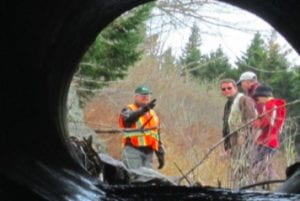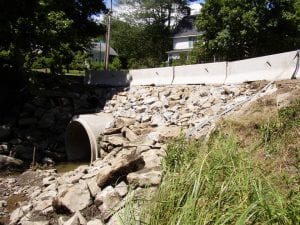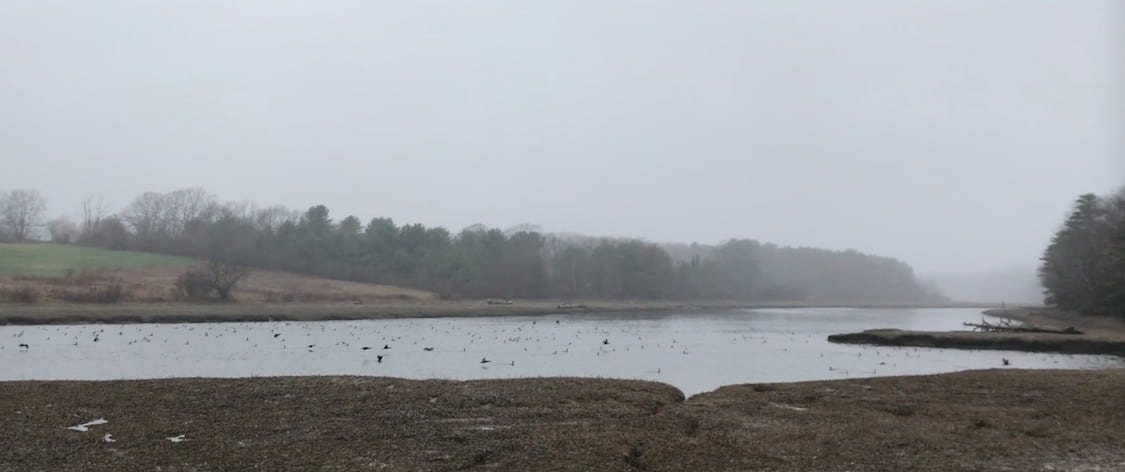
Randy Elwell, 2019
Here’s a recap of some of our oral histories about our alewife history at Ripley Creek and the marsh. Our primary source information come from community members we’ve invited into our classroom to share their experiences with alewives. Here are highlights of three visits, one from Randy Elwell this year, and the others from Lyle Morris, and then from Jeff Falla and Robert Morris.
This April (2019), Randy told us about his school days (early 1980’s) and how you’d have to walk down to Mr. Philbrook’s shop class and… “Behind the Grace Institute, down where Phoebe Bly owns now…I can remember going down there in the water with a scale basket. You know what a scale basket is…they have holes in them to let the water out…they would go down there in the crick and they would dip alewives on the tide, the high tide. Everybody in town you’d see down there getting alewives…We used to do it and actually Mr. Philbrook used to let some of the students that were fishermen go out during class and catch alewives. That would have been in the late ’70’s. I went into 6th grade in ’81. …I don’t know if you guys have been to Damariscotta, but the amount of fish that come up, that seemed to be what the crick was like, the fish would come into the crick and go up into the marsh. You just went out into the water, waded out into the water, and dipped and did whatever you could to catch fish. And I’ve heard of guys back in the day, some of the older guys in town, used to run seine twine across the cove and wait for the tide to get high and run it across when the tide went, the fish would go against the (twine) and they’d go bail them out, which is highly illegal now.”
“The mentality was that the alewives weren’t going to go away; just like anything in the fishing industry or anything it’s going to be there forever, and the crick, especially. But it did, it went away and got less and less and less.”
“My family’s been in the fishing business for generations so I grew up around it…When I was a kid…going with my father in the bait truck, the big bait truck, to the alewives trap in Warren, filling the truck and going and delivering it and then coming back and getting more…Now…you have to go and get in line or sign up to get a tray of alewives, whereas then, it was, you just went and get as much as you wanted and then took it home.”
We asked Randy if he ever ate alewives. He said, “Oh yeah (making a face). My father-in-law smoked ’em for years. He had a smoke house. He’d go over to Warren and he had a friend… ’cause as a resident of Warren you could get so many…have so many free; he would get his alewives and he would smoke ’em and people would come from, I ain’t kidding ya’, all the way from like Presque I’sle, just to get ’em. He did it for years and years…Dried fish, salt fish, peel it off and eat it. Do the same thing with the smoked alewives. The older people really liked them. They would heat them up or some people would peel them off and eat them.”

Lyle Morris, 2016
Lyle Morris told us about netting alewives for bait from what turned out to be the last native run (around 1985 or 1986). Notes from his 2016 class visit capture the following information: Lyle Morris stated that the alewife run was never large. They were caught in Ripley Creek, netted as they collected in the pools below the culvert. They were caught by perhaps 3-5 different local people for lobster and halibut bait. It would be frozen if the halibut season was over and kept for the next halibut season (a year later). As a kid he remembers three rock pools that would be fixed up year to year, so they pooled the water and fish could collect and rest in the pools before going up into the marsh with the tide. About 1985, Lyle netted about 6-8 bushels in the creek, and after that, “like a switch”, they stopped coming. He thinks he’s seen maybe two alewives there since the 1980’s.
We also have a story from two life-long friends that used to play in Ripley Creek. In March of 2016, Mr. Jeff Falla and Mr. Robert Morris came into the eighth grade class to talk to us about their memories of alewives.

Robert Morris (left) and Jeff Falla (right), 2016
When Robert and Jeff were younger, they would catch the alewives for fun with a colander and then they would flip them over the beaver dam into the marsh to help them get there. They mentioned that there was never a big run, but a couple lobstermen from Wheeler Bay did come to catch some alewives for lobster bait when the fish ran in the spring.
Robert and Jeff remembered how the sewage from houses had run from the backyards of those houses and down into the marsh. After swimming in the creek they would come out with red blotches all over their body. When the house that used to be on the granite piling over the stream flushed the toilet, it would go right into the creek. Back then, there were bottom feeding fish, like flounder, that would come all the way up the creek as far as the culvert. They explained that they believed the fish would feed off the solid waste. They used to see mackerel in the creek too. When the water quality improved, the flounder and mackerel seemed to disappear. The water is a lot cleaner today. Now, the only thing that runs into the marsh from houses is gray water. When we were working in the stream we saw water coming out of a pipe several times.










